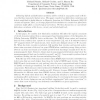ET
2007
14 years 8 months ago
2007
In this paper, different circuits of Quantum-dot Cellular Automata (QCA) are proposed for the so-called coplanar crossing. Coplanar crossing is one of the most interesting feature...
ET
2007
14 years 8 months ago
2007
The computational paradigm known as quantum-dot cellular automata (QCA) encodes binary information in the charge configuration of Coulomb-coupled quantum-dot cells. Functioning QC...
ASPDAC
2005
ACM
14 years 10 months ago
2005
ACM
— Quantum-dot Cellular Automata (QCA) is a novel computing mechanism that can represent binary information based on spatial distribution of electron charge configuration in chem...
CF
2007
ACM
15 years 4 days ago
2007
ACM
This paper presents the Collapsed Bennett Layout, a general purpose floorplan for reversible quantum-dot cellular automata (QCA) circuits. In order to exploit the full density and...
GLVLSI
1999
IEEE
15 years 14 days ago
1999
IEEE
We present a formalism for implementing circuits with Quantum-dot Cellular Automata (QCA), comprising a set of standard circuit elements with uniform layout rules. The formalism s...
ISVLSI
2003
IEEE
15 years 1 months ago
2003
IEEE
The need for small, high speed, low power computers as the end of Moore’s law approaches is driving research into nanotechnology. These novel devices have significantly differe...
SIPS
2006
IEEE
15 years 2 months ago
2006
IEEE
: Molecular electronics is commonly conceived as reproducing diode or transistor action at the molecular level. The quantum-dot cellular automata (QCA) approach offers an attractiv...
ISVLSI
2006
IEEE
15 years 2 months ago
2006
IEEE
Abstract— Research in the fields of physics, chemistry and electronics has demonstrated that Quantum-dot Cellular Automata (QCA) is a viable alternative for nano-scale computing...
ARITH
2007
IEEE
15 years 2 months ago
2007
IEEE
An emerging nanotechnology, quantum-dot cellular automata (QCA), has the potential for attractive features such as faster speed, smaller size, and lower power consumption than tra...
103
click to vote
DFT
2008
IEEE
15 years 2 months ago
2008
IEEE
Tolerating defects and fabrication variations will be critical in any system made with devices that have nanometer feature sizes. This paper considers how fabrication variations a...

